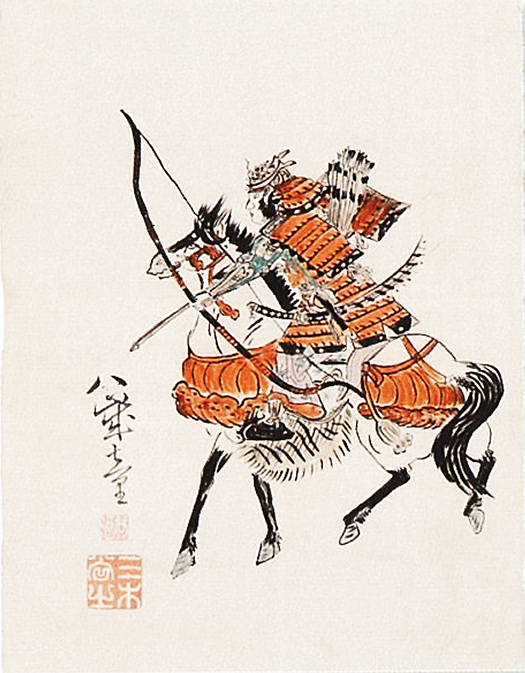
江戸期の播州での三木家のひとびとの消息がこの福崎には詳細な研究と共にあきらかにされて遺されている。この家の当地での足跡は明暦元年(1655年)に、当時の姫路藩・榊原家から「新田開発」の事業要請を受けた英賀城の末裔で酒造業などを営んでいた三木家が承って、移住してきたのだという。
江戸期の経済のなかでは当然ながら為政者たちとのさまざまな関係性は重要だっただろう。戦国期までの武士階層のメンタルはひたすら暴力的な領地拡大意欲だっただろうけれど、中央統一政権の確立によってそういう拡張主義は壁にぶち当たって、家康の施政方針として平和主義・学問や秩序重視の姿勢が貫徹して行った。
そういった社会の中で経済運営についてはそれまでの戦国期にさまざまな試行錯誤が繰り返されて、基本は農業生産でありながら、周辺的なものづくり産業から形成されていったことだろう。三木家はもっとも基本的な地域製造業として酒造に取り組み、姫路城下で一定の経済的基盤を確立していた。そういう家だからこそ、藩の側としても経済主体として未開墾の地域総合開発を任せたということかと思える。
なお、戦国期以来の英賀・三木家では戦陣食としての「乾燥麺」〜そうめんなどの技術発達があったとも言われている。縁の深い讃岐の「三木」地域でも讃岐うどんとして地域名産になっている。三木家という存在には播州のそうめん文化に一定の足跡を感じさせられる。事実、この三木家住宅の裏には「もちむぎの館」という独特の麺料理発祥を謳い文句にした名物館が存在している。
そういった来歴の三木家の福崎移住から7代目になる三木通深氏が描いたという絵画が遺されている。
かれは1824年生-1857年没と短命だったけれど、幼時から神童のほまれ高く、その学識で地域で広く敬愛されていた柳田國男の祖母に入門して学問を学んだという。江戸期というのはこういう学問への社会的崇敬心が非常に重視された社会だったことが伝わってくる。家康の開いた江戸幕府の施政が日本人に遺したDNAの深さを思わされる。
学問と同時に絵についても島琴陵・浦上春琴に師事した。そのかれが描いたのが上の絵。8歳の年齢として馬のデッサン力などまことに秀逸。こういう絵を見せられた方は「まことに神童」と目を見張ったに違いない。
学問についてもやがて大阪懐徳堂(現代の大阪大)、江戸昌平校(現代の東大)に学んだという。昌平校では林大学学頭に学んだのだという。
しかし経済的には7歳で大庄屋を拝命したけれど、叔父の後見を受け、その留学費用などや著名な文人墨客との交友が家政を傾け、三木家の財産を半減させたと言われている。

8歳の子どもが一心不乱にこの絵に意識を集中して、細部にまで想像力を注ぎ込んだ様子が、筆使いの端々に強く印象づけられる。たぶん絵を描くに際しての少年の忘我の集中力に接したひとびとは、つばを飲み込むほどに愛を注がざるを得なかったことだろう。そういう状況が絵から伝わってくる。
English version
Painting by Michihisa Miki, a child prodigy of the village headman’s family, at the age of 8 in 1831.
My basic theme for many years has been “people and home,” and the paintings left behind by my predecessors convey a sense of their way of life. It is a vivid realization. I am very grateful to the artist for his kindness and generosity.
The history of the Miki family in Banshu during the Edo period (1603-1868) is well documented in Fukusaki, and has been left behind through detailed research. The Miki family’s history in Banshu dates back to 1655, when the Sakakibara family of the Himeji domain at that time asked the Miki family, descendants of the Eiga Castle family, who were engaged in the sake brewing business, to develop new rice paddies in the area.
Naturally, relationships with government officials were important in the Edo period economy. Until the Warring States period, the warrior class’s mentality was one of violent territorial expansion, but with the establishment of a unified central government, such expansionism ran into a wall, and Ieyasu’s policy of pacifism and an emphasis on learning and order came into effect.
In such a society, economic management was subject to a variety of trial and error during the Warring States period, and while the foundation of the economy was agricultural production, it was also formed from peripheral manufacturing industries. The Miki family was involved in sake brewing as the most basic local manufacturing industry and had established a certain economic base under Himeji Castle. It is precisely because the Miki family was such a family that the clan entrusted the comprehensive development of the uncultivated area to them as an economic entity.
It is also said that since the Warring States period, the Eiga and Miki families have developed the technology of “dried noodles” or “somen” as a battle food. In the Miki region of Sanuki, which is closely related to the Miki family, Sanuki udon is also a regional specialty. The Miki family’s presence in Banshu’s somen culture has left a certain mark on the region. In fact, behind the Miki family’s residence is the Mochimugi no Yakata, a specialty museum that claims to be the birthplace of a unique noodle dish.
There is a painting by Michihisa Miki, the seventh generation of the Miki family to immigrate to Fukuzaki, that depicts this family history.
He was a child prodigy and was widely respected for his learning by his grandmother, Kunio Yanagida, who studied under her. The Edo period (1603-1867) was a time when social reverence for learning was highly valued in society. This reminds us of the depth of the DNA bequeathed to the Japanese people by the administration of the Edo shogunate established by Ieyasu.
In addition to his studies, Ieyasu studied painting under Shima Kinryo and Urakami Shunkin. The above picture was painted by him, and his drawing of a horse at the age of 8 is truly outstanding. The person who was shown this kind of picture must have been awestruck, saying, “He is truly a child prodigy.
In terms of studies, he studied at Osaka Kaitoku-do (today’s Osaka University) and Edo Shohei-gakko (today’s University of Tokyo). At the Changping School, he studied under the dean of Hayashi University.
However, financially, although he was given the title of “daimyo-ya” (village headman) at the age of seven, he was looked after by his uncle, and it is said that his study abroad expenses and his friendship with famous writers and artists caused the family’s finances to decline, reducing the Miki family’s wealth by half.
The way the eight-year-old concentrated his mind and imagination on this painting, pouring his imagination into every detail, is strongly evident in every brushstroke. Perhaps those who came in contact with the boy’s selfless concentration as he painted must have felt compelled to love him so much that they swallowed their spit. This situation is conveyed through the painting.
Posted on 10月 31st, 2023 by 三木 奎吾
Filed under: 住宅マーケティング, 歴史探訪








コメントを投稿
「※誹謗中傷や、悪意のある書き込み、営利目的などのコメントを防ぐために、投稿された全てのコメントは一時的に保留されますのでご了承ください。」
You must be logged in to post a comment.